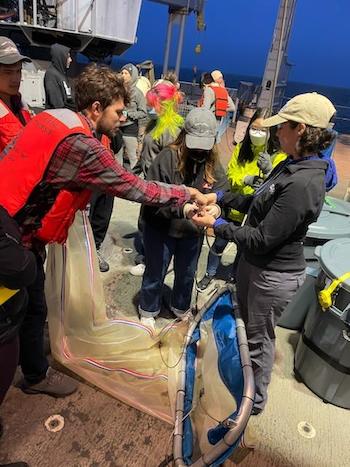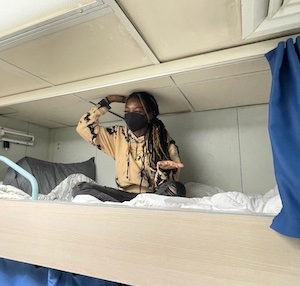Shipboard program open to all undergraduate majors
As a Vanderbilt undergraduate, Miguel Moravec took part in a research cruise that used multibeam sonar to map areas of the Queen Charlotte Fault off the Southeast Alaskan coast. He and other students also visited Exit Glacier Park and saw first-hand how fast glacier ice had receded over the past 50 years.

“It was really impactful,” said Moravec, now a Ph.D. student in civil and environmental engineering. “I really wanted to get involved in climate change.”
Moravec also wanted to stay involved with the STEMSEAS, program that gave him the onboard experience. He recently returned from his first expedition as a STEMSEAS mentor, helping introduce a group of community college students from Washington to the wide range of NSF-funded research at sea, including geoscience, oceanography and engineering. The cruise aboard R/V Thomas G. Thompson spanned seven days and 1,000 nautical miles, from Seattle to San Diego.

It was the first STEMSEAS expedition since the start of the COVID-19 pandemic, and applications are open for five other trips planned through September 2022. The application deadline for the next cruise, in April 2022, is February 6. The program is open to all undergraduates, regardless of major, and participants must comply with enhanced maritime industry COVID precautions.
While onboard, the students worked in teams to complete research projects employing the ship’s scientific instruments, ranging from fluorescence sensors to microplastic tow nets. They did everything from measuring cyanobacteria activity to documenting changes ocean acidity and temperature and salinity using probes that fell to the sea floor.
In addition to supervising these projects with other mentors, Moravec talked with students about potential careers and shared a lecture about his research in agent-based modeling of maritime systems.

Experiential programs such as STEMSEAS are vital for increasing diversity in STEM fields, he said.
“The students were surprised to see how many of the scientists and crew members were just like them,” he said. “So many of the students described the experience as transformative and welcoming for them,” he said.
In fact, Moravec produced a three-minute video in 2020 that highlights STEMSEAS’ efforts in making geosciences more diverse, inclusive and equitable.
“I’m proud to be part of a program that helps students realize that STEM can be inclusive to everyone, regardless of your background,” he said.
Media contact
Pamela Coyle
School of Engineering